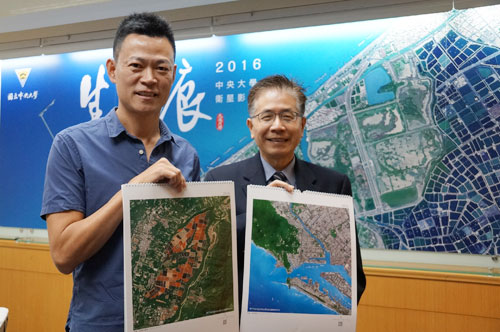NCU Satellite Image Calendar “Trace of Life”—A Witness of Our Land

The pictures in the 2016 Satellite Image Calendar “Trace of Life”: the left is the satellite image of Laobei Farm at Neipu in Pingtung County, and the photo on the right is the image of No.6 Naphtha Cracker Complex at Mailiao in Yunlin County. PHOTO: CSRSR
“Trace of life” means the traces left by creatures’ biological activities on earth. It could be as large as a footprint of a dinosaur, or as tiny as a hole that an insect drills in the soil. The Center for Space and Remote Sensing Research (CSRSR) of NCU makes the “Trace of Life” the central theme in the satellite image calendar of 2016. CSRSR selected six images in Taiwan seen by the SPOT satellites of France, presenting the landscapes of Wusanto Reservoir in Tainan City, Laobei Farm at Neipu in Pingtung County, Cieding Fishing Farm in Kaohsiung City, No.6 Naphtha Cracker Complex at Mailiao in Yunlin County, the Permanent Housing Area at Shanlin District in Kaohsiung City, and the Port of Kaohsiung.
“The core value of the satellite image calendar is the concern for humanity. The design concept for this calendar is the reflection on humans’ activities on Earth. Through those images seen by satellites, we would see the massive trace that humans have carved on the earth with the planned landscape-changing activities and man-made environment creation,” said Dr. Chung-Pai Chang, Professor in CSRSR and the curator of the calendar “Trace of Life.”
“The documentary film Beyond Beauty: Taiwan from above observes Taiwan from the sky and presents the beautiful and the fragmented of Taiwan. Our satellite image calendar observes Taiwan from a different angle—from outer space, which shows us different visions and perspectives,” said Dr. Jing-Yang Jou, the president of NCU.
The six pictures in the calendar are arranged ingeniously and tell the symbolic change in sequence. The images start from humans’ essential needs to the demand on changing living environments, and from agriculture and fish-farming to industry and larger-scale economic activities. People may observe from these images humans’ change of living environment and the rise in quality of life in those man-made landscapes in the natural environment.
Related links



